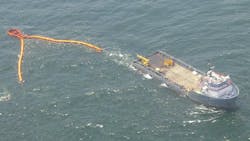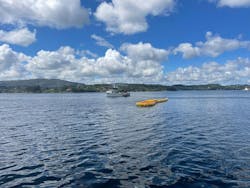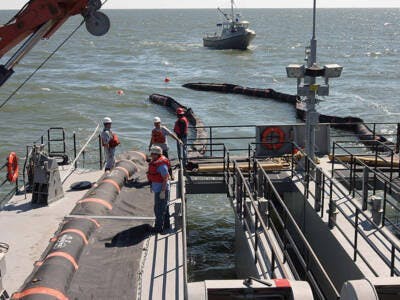Offshore spill response evolving in era of zero tolerance
Key Highlights
- Operators face higher risks due to aging infrastructure, harsher conditions and increased societal expectations for rapid, transparent spill response.
- Pre-incident collaboration, joint planning and realistic exercises significantly improve response efficiency and environmental outcomes.
- Technology should complement core capabilities; organizations that integrate advanced tools with well-trained teams perform best during offshore incidents.
By Ariana Hurtado, Editor-in-Chief
Operators face mounting complexity in spill response and environmental safety as offshore assets, aging infrastructure and harsher conditions collide with zero-tolerance expectations.
QT Environmental, an oil spill response and prevention specialist, provides consulting, training, equipment and staffing to combat and remediate oil spills, partnering with offshore energy equipment and services providers across the globe.
Josh Clifford, vice president of QT Environmental, discussed with Offshore how evolving regulations, advanced technologies and collaborative planning are reshaping emergency preparedness offshore.
Offshore: What are the most significant challenges offshore oil and gas operators face today in oil spill response and environmental safety, and how are these evolving with new regulations and technologies?
Clifford: One of the biggest challenges offshore operators face is that the risk profile is getting more complex while the tolerance for failure is zero. Deepwater assets, aging infrastructure, harsher weather, busier marine corridors, larger vessels and alternative fuels all increase the potential consequence of an incident.
At the same time, regulators and the public expect faster, more transparent and more effective response than ever before. That tension between operational complexity and societal expectations is where most of the real work is happening today.
We’re seeing regulations push operators toward better worst-case discharge planning, more realistic exercises and clearer lines of accountability. On the technology side, there’s real progress with remote sensing, real-time metocean data, and advanced mechanical recovery and containment systems that can operate in higher sea states and currents, including technology like NOFI Current Busters.
The challenge is more than simple investment in technology; it’s integrating it into plans, proper training of people, and logistics, so that when something happens offshore, the operator, regulators and response partners are already aligned on how to use it.
Offshore: Can you share a recent offshore case study where your team was involved in emergency response? What were the key lessons learned for the operator(s) and service provider(s)?
Clifford: Recently, our team supported an offshore operator in the Gulf of America during a subsea release that had the potential to impact sensitive coastal resources if not contained quickly. The operator had strong preparedness on paper—plans, equipment lists, contractor relationships—but the real test came down to how quickly we could convert those plans into action in an environment with strong currents, limited weather windows and a lot of simultaneous operational priorities.
Within hours, we were mobilizing offshore containment and recovery systems, integrating with the operator’s incident management team, and working side by side with regulatory agencies in a unified command structure. The offshore conditions demanded high-encounter, advancing recovery strategies rather than purely static boom, and we had to constantly adjust tactics based on updated metocean data and overflights. What made the difference was that the operator had pre-identified response partners, pre-negotiated contracts and had trained their teams on how to plug those capabilities straight into their command structure. We weren’t meeting each other for the first time in the middle of the incident.
For the operator, key lessons included the value of true scenario-based planning—going beyond generic plans to stress-test specific failure modes, logistics bottlenecks and weather constraints for their actual assets. They also saw how important it is to exercise not just their own staff, but their extended response 'ecosystem:' service providers, OSROs [oil spill response organizations], vessel operators and regulators. When everyone has practiced working together, you get better, faster decisions offshore and far less friction in approvals and tactical shifts.
For service providers, like us, the lessons were about readiness and adaptability. Having sophisticated offshore systems doesn’t help if they’re not configured, maintained and crew-ready for the specific region and season. We also reinforced the importance of honest after-action reviews—looking at what worked, what didn’t, and where communication or logistics slowed us down. The strongest relationships we have with operators are the ones where those debriefs are candid and lead directly to improved plans, updated equipment strategies and better joint exercises, not just a report that sits on a shelf.
Offshore: How do advancements in containment technologies address gaps in traditional spill response strategies, particularly in deepwater or harsh environments?
Clifford: Traditional strategies—long stretches of boom, near-shore staging and low-encounter skimming—were never designed for high-current, offshore environments or deepwater releases.
Newer containment and recovery systems focus on increasing encounter rate, keeping oil in thicker, more recoverable slicks, and staying effective in higher sea states and currents. That shift is critical offshore, where you can’t control the environment but you can design systems that work with it instead of against it.
We’re also seeing more modular, integrated approaches: systems that combine containment, recovery and temporary storage on a single platform or vessel, with configurations tuned to specific basins. In deepwater and harsh environments, that integration reduces transfer points, shortens response time and allows operators to push effective recovery farther offshore, closer to the source.
In practice, these technologies close the gap between what plans historically promised and what could actually be delivered on the water under real-world conditions.
Offshore: What role does collaboration between operators, regulators and response specialists play in improving preparedness and minimizing environmental impact during offshore incidents?
Clifford: Collaboration is the difference between a plan that reads well and a response that performs well. Operators understand their assets and production risks; regulators set expectations and guardrails; response specialists bring practical knowledge of what actually works offshore at 2 a.m. in marginal conditions. If those three groups are only really talking to each other during an incident, you’ve already lost valuable time and alignment.
The most effective offshore responses we’ve been part of are built long before an incident through joint planning workshops, realistic exercises and shared scenario modeling. When operators invite regulators and response partners into that process early, you get pre-agreed tactical options, clearer thresholds for escalating resources and mutual trust. That shows up during an incident as faster approvals, more flexible tactics and a shared focus on outcomes—minimizing environmental impact and safely returning to normal operations—rather than debating fundamentals while the clock is ticking.
Source: QT Environmental YouTube; 2023
Offshore: What innovations or operational practices do you see shaping the future of offshore spill prevention and emergency response over the next five years?
Clifford: Over the next five years, I think we’ll see three trends really shape offshore preparedness. First, better use of data and predictive tools—integrating metocean models, asset integrity data, and real-time monitoring to anticipate failure modes and to pre-position equipment and vessels based on weather and current forecasts. That will blur the line between prevention and response, because the same data systems support both.
Secondly, I see operators and service providers putting more emphasis on sustained competency—building and retaining experienced incident management and offshore response teams, not just relying on a small group of specialists. Technology will keep advancing, but in offshore incidents, the real differentiator will still be how well people, systems and partners are integrated before anything goes wrong.
Lastly, I see a shift back toward mastering the fundamentals. There’s a lot of attention right now on cutting-edge tools—AI-driven monitoring, autonomous vessels, remote operations—which absolutely have value and will continue to mature. But offshore response doesn’t happen in a controlled environment; it happens in wind, waves, current and uncertainty. In those conditions, the basics remain the backbone: disciplined incident management, well-trained operators, robust containment and recovery tactics, realistic equipment placement, and strong logistics.
Technology can enhance those fundamentals, but it cannot replace them. We’ve seen situations where operators invest heavily in advanced systems yet still struggle because their teams haven’t exercised together, their equipment isn’t maintained to offshore standards or their decision-making process breaks down during the first few hours of an incident.
In every major response I’ve been part of—whether assisting an operator in the Gulf of America or supporting a North Sea operator dealing with a complex release—the organizations that performed the best were the ones that treated technology as an enabler, not a substitute for core capability.
The future will absolutely incorporate AI, autonomy and advanced analytics, but their real power comes from reinforcing the basics, not bypassing them.
Want more content like this?
Operators need to modernize offshore spill management
Despite EU-level coordination, Europe’s offshore oil spill response remains deeply fragmented in practice.
Njord A oil spill under investigation
The Norwegian Ocean Industry Authority (Havtil) is investigating an oil spill from the Equinor-operated Njord A platform in the Norwegian Sea at the end of 2024.
AI is set to protect sea life and offshore operations resources from oil leaks
AI and video analytics technologies are transforming oil spill detection and response, delivering 24/7 monitoring capabilities and early warning systems.
About the Author
Ariana Hurtado
Editor-in-Chief
With more than a decade of copy editing, project management and journalism experience, Ariana Hurtado is a seasoned managing editor born and raised in the energy capital of the world—Houston, Texas. She currently serves as editor-in-chief of Offshore, overseeing the editorial team, its content and the brand's growth from a digital perspective.
Utilizing her editorial expertise, she manages digital media for the Offshore team. She also helps create and oversee new special industry reports and revolutionizes existing supplements, while also contributing content to Offshore's magazine, newsletters and website as a copy editor and writer.
Prior to her current role, she served as Offshore's editor and director of special reports from April 2022 to December 2024. Before joining Offshore, she served as senior managing editor of publications with Hart Energy. Prior to her nearly nine years with Hart, she worked on the copy desk as a news editor at the Houston Chronicle.
She graduated magna cum laude with a bachelor's degree in journalism from the University of Houston.





